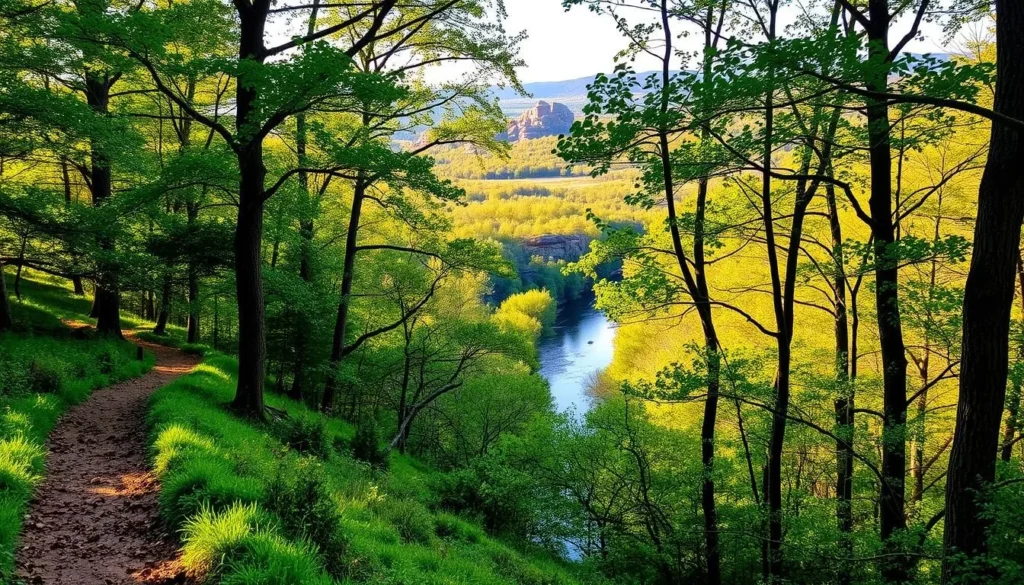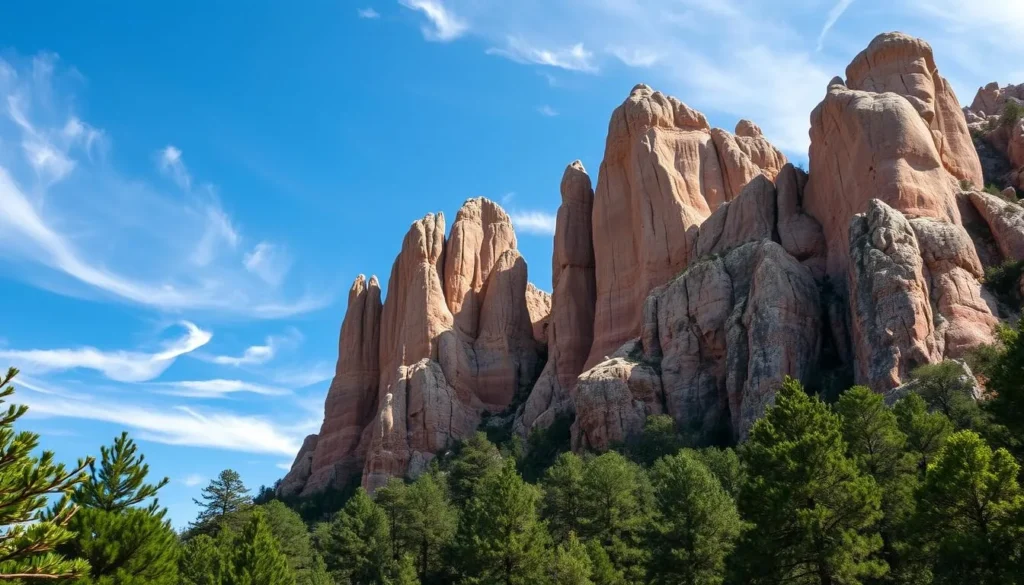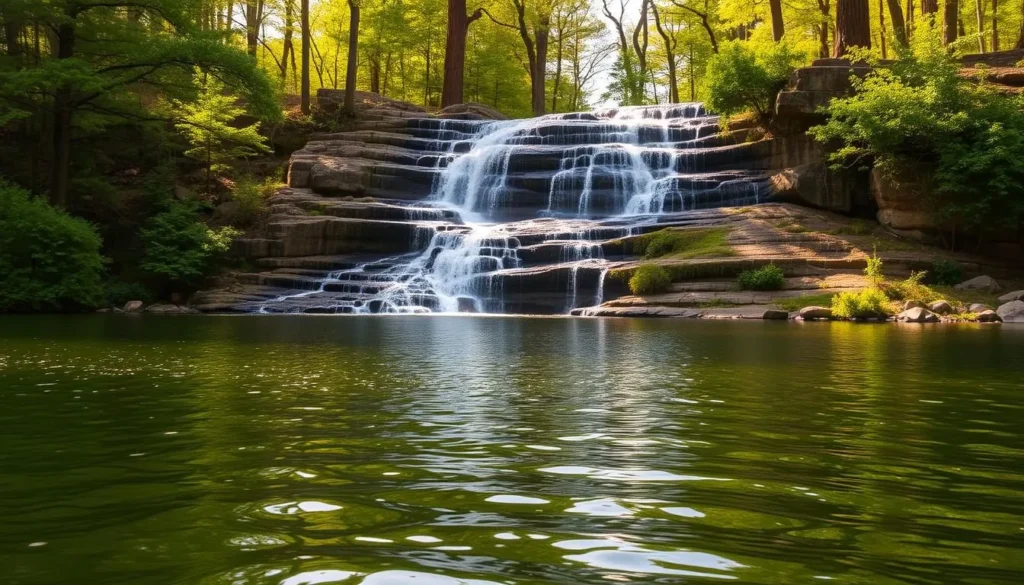✓ Accommodations✓ Flights✓ Rental Cars
Imagine a landscape that’s vastly different from the typical prairie lands of Illinois. 289,000 acres of diverse terrain await your exploration in southern Illinois, where the Shawnee National Forest offers a unique blend of forests, open lands, canyons, and bluffs.
This lesser-known destination is a treasure trove of natural beauty, featuring unique geological formations, lush forests, and scenic waterways. The forest is divided into eastern and western sections, each offering distinct experiences and attractions that cater to a wide range of interests.
As you plan your visit, you can look forward to hiking iconic trails, exploring unique rock formations, and experiencing the forest’s seasonal natural phenomena. Whether you’re a nature enthusiast or an adventure seeker, Shawnee National Forest promises an unforgettable experience.
Discovering Southern Illinois’ Hidden Gem
Shawnee National Forest, a hidden gem in Southern Illinois, offers a unique blend of natural beauty and adventure. This national forest is a must-visit destination for anyone looking to explore the great outdoors.

What Makes Shawnee National Forest Unique
Shawnee National Forest stands out from typical Illinois landscapes due to its dramatic topography, shaped by glacial activity. The forest’s unique position between the Mississippi and Ohio Rivers creates a convergence of ecosystems, supporting diverse plant and animal life. The area boasts geological diversity, featuring sandstone bluffs, limestone caves, and cypress swamps, making it feel more like the Ozarks than Illinois.
- The forest is divided into eastern and western sections, each with distinct characteristics worth exploring.
- The diverse ecosystems support a wide range of flora and fauna.
- Geological formations offer breathtaking scenery and opportunities for exploration.
Best Seasons to Visit
The Shawnee National Forest is a year-round destination, but the best time visit depends on your preferences. Here’s what you can expect during each season:
- Spring: Wildflowers bloom, waterfalls are at their peak, and wildlife is active.
- Summer: Ideal for water activities and enjoying the warm weather.
- Fall: Spectacular foliage displays make it a great time for hiking and photography.
- Winter: Offers peaceful hiking trails with fewer crowds, perfect for solitude seekers.
While there’s never a wrong time visit Shawnee National Forest, spring is particularly rewarding with its blooming flowers and enhanced waterfalls.
Garden of the Gods: Shawnee’s Crown Jewel

Shawnee National Forest’s crown jewel, Garden of the Gods, is a sight to behold. This natural wonder is renowned for its breathtaking scenery and unique geological formations that have been shaped over 320 million years ago. As the most iconic and photographed area of Shawnee National Forest, Garden of the Gods offers a plethora of activities including hiking, camping, and picnicking amidst its dramatic landscapes.
Observation Trail Highlights
The Observation Trail is a half-mile loop that takes you through some of the most spectacular rock formations in the area. This accessible trail is dotted with benches, allowing you to pause and take in the views. As you walk, look out for notable formations like Camel Rock, Monkey Face, and Turtle Rock, which are sure to captivate both kids and adults alike. The trail features small, sharp inclines and steps, but the payoff is well worth the effort, with sheer cliffs and expansive vistas that will leave you breathless.
Photography Tips and Best Viewpoints
For photographers, Garden of the Gods is a paradise. The best times to capture the beauty of the rock formations are during the early morning and at sunset when the light casts dramatic shadows. To get the most out of your photography session, consider using a wide-angle lens to capture the expansive landscapes and a tripod for low-light conditions. Some of the most photogenic viewpoints include the main overlooks along the Observation Trail, where you can capture panoramic vistas of the surrounding forest. Visiting on weekdays or during off-peak seasons can also help you avoid crowds in your photographs.
Top Hiking Trails in Shawnee National Forest
Discover the best hiking trails in Shawnee National Forest, suitable for both beginners and experienced hikers. The forest offers a variety of trails that cater to different skill levels and preferences, ensuring an enjoyable experience for everyone.
Rim Rock and Ox-Lot Cave Trail
The Rim Rock Recreation Trail is a moderate 1.7-mile loop that begins on a paved path through ancient oak trees, some of which are 200 to 300 years old. As you continue along the rim of a rock ridge, you’ll enjoy vantage points of the canyon below. The trail features an intriguing staircase that descends into rock crevices, leading to the natural shelter of Ox-Lot Cave. This cave was historically used as a corral for livestock, adding a touch of history to your hike.
Trail Highlights: Ancient oak trees, rock ridge views, Ox-Lot Cave
Little Grand Canyon Trail
The Little Grand Canyon Trail is a 3.4-mile loop that offers breathtaking views of forests, the canyon, and various water features. Rated as moderately challenging, this trail is ideal for a few hours of hiking. Be cautious of slippery conditions, especially after rainstorms, and consider wearing proper hiking shoes and bringing hiking poles for extra traction.
Seasonal waterfalls and streams appear after rainfall, enhancing the trail’s natural beauty.
| Trail Name | Distance | Difficulty |
|---|---|---|
| Rim Rock and Ox-Lot Cave Trail | 1.7 miles | Moderate |
| Little Grand Canyon Trail | 3.4 miles | Moderately Challenging |
| Trillium Trail | 1 mile | Moderate |
Trillium Trail
Trillium Trail is a moderate 1-mile loop, perfect for families and casual hikers. It’s particularly enjoyable in the spring when the trillium flowers bloom. This dog-friendly trail offers a quick but satisfying forest experience with minimal elevation change.

Whether you’re a seasoned hiker or just starting out, Shawnee National Forest’s diverse trails have something to offer. From the scenic views of the Rim Rock and Ox-Lot Cave Trail to the beautiful wildflowers on the Trillium Trail, you’re sure to have a memorable hiking experience.
Exploring Unique Rock Formations
As you explore Shawnee National Forest, you’ll discover unique rock formations that have been shaped by millions of years of geological processes. The forest’s diverse landscape has been carved out through erosion, weathering, and other natural forces, resulting in breathtaking formations that attract visitors from all over.

Stone Face
One of the forest’s most remarkable rock features is Stone Face, a natural formation that bears an uncanny resemblance to a human profile. This striking formation is more realistic than similar ones found in other states, making it a must-see place to visit. To reach Stone Face, you have two trail options: a three-mile hike from the Tecumseh statue or a shorter half-mile option from the Stone Face parking lot.
The trail is initially steep and rocky, passing through an arch formed by a fallen boulder. However, it opens up to a smooth path before reaching the carved face and a beautiful overlook. The panoramic view accompanying Stone Face makes the climb worthwhile.
Devil’s Standtable
Another highly sought-after spot in Shawnee National Forest is Devil’s Standtable, known for its distinctive table-like rock formations. This unique shape creates a stunning photo backdrop, making it one of the most photographed spots in the forest. Visitors can enjoy the visual appeal of Devil’s Standtable against the lush forest backdrop.
- Tips for visiting Devil’s Standtable include arriving early to avoid crowds and capturing photographs during the golden hour.
- Combining a trip to Devil’s Standtable with nearby trails can provide a more complete experience.
By exploring these unique rock formations, you’ll gain a deeper appreciation for the natural beauty and geological history of Shawnee National Forest.
Water Wonders: Rivers, Lakes and Falls
As you explore Shawnee National Forest, you’ll discover a variety of water wonders that add to the area’s natural charm. The forest is home to numerous rivers, lakes, and waterfalls, each offering a unique experience.
Burden Falls
One of the forest’s most notable water features is Burden Falls, considered one of the highest waterfalls in Illinois at 100 feet. The falls are particularly picturesque during spring and fall when the water is gushing down. Even in winter, when the water trickles, the upper view remains serene and beautiful.
You can access both the upper and lower viewing areas, though the difficulty level varies. The upper view provides a broad perspective, while the lower view offers a more intimate experience with the falls.
Bell Smith Springs
Bell Smith Springs Recreation Area is another highlight, featuring crystal blue waters and unique rock formations. The white trail here is a 1.5-mile loop that follows a ridgeline along a bluff, offering stunning views of the creek below before descending into the scenic canyon.
The area is also home to a natural arch, visible via the yellow trail when water levels permit. This is a great place to explore and enjoy the natural beauty of Shawnee National Forest.
Cache River Wetlands
The Cache River Wetlands offer a surprising swampland ecosystem that feels more like Louisiana than Illinois. The ancient cypress-tupelo swamp is home to thousand-year-old trees, including a champion water tupelo tree measuring 23 feet in circumference.
A visit to Heron Pond allows you to walk along a floating boardwalk hovering over a green marsh teeming with bald cypresses and water tupelos. This unique wetland ecosystem is a must-see when visiting Shawnee National Forest.
| Water Feature | Location | Highlights |
|---|---|---|
| Burden Falls | Shawnee National Forest | 100-foot waterfall, scenic views |
| Bell Smith Springs | Recreation Area | Crystal blue waters, natural arch |
| Cache River Wetlands | Heron Pond | Ancient cypress-tupelo swamp, floating boardwalk |

Cave Explorations in Shawnee National Forest

As you venture into the depths of Shawnee National Forest, you’ll discover a fascinating world of cave explorations. The forest is home to numerous caves, each with its unique history and geological significance. One of the most notable caves in the area is Cave-in-Rock, located along the Ohio River.
Cave-in-Rock: History and Highlights
Cave-in-Rock is a massive limestone cave with a 55-foot wide opening that resembles a giant speech bubble. Throughout the late 18th and early 19th centuries, this cave served as a hideout for river pirates, counterfeiters, and bandits. The most infamous legend associated with the cave is that of Captain Samuel Mason, a lifelong criminal and pirate who made Cave-in-Rock the center of his criminal enterprise in 1797. Mason and his gang targeted riverboats on the Ohio River and homes while people were at church.
The cave’s history has also been immortalized in popular culture, featuring in films such as “How the West Was Won” by MGM in the 1960s and “Davy Crockett and the River Pirates” by Disney in the 1950s. Visitors can explore the cave and its surroundings, which are now part of Cave-in-Rock State Park.
Other Notable Caves
In addition to Cave-in-Rock, Shawnee National Forest is home to other notable caves that are worth exploring. Visitors can discover these hidden gems, such as those found near Rim Rock, and experience the natural beauty and historical significance of the area. When exploring these caves, it’s essential to take safety precautions, including wearing appropriate gear and respecting the fragile environments.
Before planning your visit, be sure to check for any seasonal considerations, such as potential flooding during rainy periods or bat hibernation seasons when some caves might be closed. By being mindful of these factors, you can ensure a safe and enjoyable cave exploration experience in Shawnee National Forest.
Adventure Activities for Thrill Seekers
If you’re looking for excitement beyond hiking and camping, Shawnee National Forest has got you covered with its array of adventure activities. The forest is a haven for those seeking adrenaline-pumping experiences, offering a range of thrilling activities that cater to different interests and skill levels.

Shawnee Bluffs Canopy Tour
The Shawnee Bluffs Canopy Tour is a premier zipline experience that takes you on a three-hour aerial adventure through the forest canopy. This comprehensive treetop tour includes 8 ziplines, 3 suspension bridges, and short connecting hikes, providing a thrilling way to explore the forest’s upper reaches. For those seeking a shorter experience, the Chipmunk Canyon Run is an alternative, featuring 5 ziplines and 2 aerial bridges.
Before booking, it’s essential to check the weight restrictions and dress appropriately for the tour. Reservations are recommended to ensure availability.
Rock Climbing and Rappelling Spots
For rock climbing enthusiasts, Shawnee National Forest offers numerous unique rock formations and climbing routes. Jackson Falls in the Hidden Springs Ranger District is a premier climbing destination, featuring a variety of routes for different skill levels, from beginner-friendly faces to challenging overhangs. Climbers must bring their own equipment, as rentals are not available within the park.
It’s crucial to check current conditions and any closures due to weather or wildlife protection before heading out. Experienced climbers can also explore additional climbing areas in southern Illinois outside the park boundaries.
Horseback Riding Through the Forest

Discover the beauty of Shawnee National Forest from a new perspective with horseback riding. This activity offers a unique way to experience the forest’s diverse landscapes, allowing you to access areas that might be challenging on foot.
Guided Trail Rides
For a memorable horseback riding experience, Giant City Stables is highly recommended. They offer guided trail rides led by experienced guides who instruct you throughout the ride. Their horses are well-trained for trail riding, making it suitable for riders of various experience levels.
The guided trail rides at Giant City Stables come in different durations and difficulty levels, ensuring there’s an option for everyone. As you ride through the forest, you’ll enjoy breathtaking views and scenic routes that showcase the natural beauty of Shawnee National Forest.
What to Expect as a Beginner
If you’re new to horseback riding, don’t worry – no prior experience is necessary for most guided trail rides. Guides will provide a brief orientation and safety instructions before you head out on the trail. It’s recommended to wear long pants and closed-toe shoes for comfort and safety.
Most trail horses are selected for their calm temperament, making them ideal for novice riders. With the guidance of experienced instructors, you’ll learn basic riding posture and how to navigate the trail with ease.
Wildlife Viewing and Nature Photography
Shawnee National Forest is a haven for wildlife enthusiasts and nature photographers alike, offering diverse ecosystems that support a wide range of flora and fauna. The forest’s unique location at the convergence of northern and southern ecosystems creates a habitat for an unusually diverse range of plant and animal species.
Best Spots for Birdwatching
The Cache River State Natural Area is a standout location for birdwatching, spanning over 18,000 acres of expansive wetlands and cypress trees. This area is renowned for its outdoor recreational opportunities, including hiking, canoeing, and fishing. Visitors can spot both resident and migratory bird species, making it a paradise for bird enthusiasts.
Other prime birdwatching locations throughout the forest include specific trails, wetlands, and observation points. To maximize your birdwatching experience, consider bringing essential equipment such as binoculars, field guides, and appropriate clothing for varying weather conditions.
| Location | Bird Species | Best Time |
|---|---|---|
| Cache River State Natural Area | Migratory and resident species | Spring and Fall |
| Trillium Trail | Warblers, woodpeckers | Spring |
| Little Grand Canyon Trail | Raptors, wetland birds | Summer |
Seasonal Wildlife Highlights
The Shawnee National Forest offers exciting wildlife viewing opportunities throughout the year. During the spring migration, witness the colorful abundance of warblers and other songbirds. Summer brings resident species like raptors, woodpeckers, and wetland birds.
In the fall and winter, look out for bald eagles wintering along the rivers and waterfowl using the forest as a stopover on their migration routes. To ensure respectful wildlife viewing and photography, keep a safe distance from animals and avoid disturbing their habitats.

Shawnee National Forest, Illinois: Best Things to Do in Every Season
As the seasons change, Shawnee National Forest reveals its diverse beauty, from spring wildflowers to winter landscapes. This transformation offers visitors completely different experiences throughout the year, making Shawnee National Forest a unique destination regardless of when you visit.
Spring Wildflowers and Waterfalls
Spring is a magical time in Shawnee National Forest, with wildflowers carpeting the forest floor. You’ll see trillium, bluebells, and wild orchids blooming in vibrant colors. Spring rains enhance the forest’s numerous waterfalls, making it the optimal time to visit Burden Falls and Jackson Falls.
- Explore the forest’s wildflowers on guided tours or self-guided trails.
- Visit waterfalls at their peak flow after spring rains.
Summer Water Activities
Summer brings warmth to Shawnee National Forest, making its lakes and rivers perfect for water activities. You can enjoy swimming at Pounds Hollow Recreation Area, fishing at Little Grassy Lake, or canoeing/kayaking on the Cache River.
- Cool off with a swim or try your hand at fishing.
- Paddle through the calm waters of the Cache River.
Fall Foliage Viewing
Autumn transforms Shawnee National Forest into a kaleidoscope of colors as the hardwood trees change. The peak color typically occurs from mid-October to early November. Take a scenic drive or hike to overlooks to witness the spectacular fall foliage.
- Plan your visit during peak foliage for the best views.
- Explore scenic drives and hiking trails for optimal viewing.
Winter Hiking and Solitude
Winter brings a serene peace to Shawnee National Forest, with fewer crowds and a landscape transformed by snow. It’s an ideal time for hiking and solitude. The bare trees reveal rock formations and vistas, creating a unique winter wonderland.
- Enjoy peaceful hiking trails with fewer visitors.
- Experience the forest’s serene beauty under a blanket of snow.
Where to Stay: Lodging Options
Whether you’re looking for a cozy cabin or a campsite, Shawnee National Forest has something for everyone. The area offers a variety of lodging options to suit different tastes and budgets, ensuring a comfortable stay while you explore the forest’s natural beauty.

Giant City Lodge and Cabins
The historic Giant City State Park Lodge, built by the Civilian Conservation Corps in the 1930s, is a standout accommodation option. Its distinctive rustic architecture and warm hospitality make it a great place to stay. The lodge offers comfortable rooms and 34 cabins ranging from rustic one-room structures to more upscale bluff-side cabins.
Guests can enjoy family-style fried chicken dinners at the lodge’s restaurant and take advantage of the proximity to trails for morning hikes. The cabins, while not having cooking facilities, are within walking distance to the lodge and picnic grounds where you can grill out.
Camping in Shawnee National Forest
For those who prefer camping, Shawnee National Forest has various developed campgrounds, including Little Grassy Lake Campground and Marina. This campground offers beautiful lake views, RV spots, tent sites, shower facilities, and electrical hookups. You can also rent a boat from the marina for a day on the lake.
For a more primitive experience, backcountry camping is available with necessary permits and regulations to follow.
Nearby Towns and Accommodations
If you prefer to stay in nearby towns, communities like Carbondale, Anna, and Harrisburg offer additional lodging options. You can find Shawnee Forest Cabins with private hot tubs and unique accommodations like the Treehouse cabin with a suspension bridge leading to a private hot tub in the trees.
Staying in nearby towns also provides access to restaurants, grocery stores, and other conveniences while remaining a short drive from forest attractions.
Dining and Local Flavors
As you explore the natural beauty of Shawnee National Forest, you’ll discover that the surrounding area is also a treat for your taste buds. The dining scene here offers a delicious blend of hearty Midwestern fare, Southern influences, and locally-sourced ingredients, making it a great place to indulge in local flavors.
Best Restaurants Near Shawnee National Forest
While dining options within Shawnee National Forest itself are limited, the surrounding communities offer a variety of restaurants worth exploring. One local favorite is Trails End Restaurant, attached to Double M Campground, known for its friendly staff and excellent fried catfish. Another standout is The Diver Down in Golconda, which serves fantastic crab and cheese stuffed mushrooms and catfish with a delightful mustard-based tartar sauce. For a casual treat, Garden of the Gods Outpost is a great place to stop for ice cream, cold drinks, and snacks while getting helpful information about the area.

Local Specialties to Try
The region around Shawnee National Forest is known for its unique culinary heritage, featuring dishes such as catfish prepared in various ways, burgoo (a hearty stew), and regional barbecue styles. You should also try seasonal specialties like pawpaw fruit, persimmons, and locally-produced honey and sorghum. For beverages, consider exploring craft beers from regional microbreweries and wines from the Shawnee Hills Wine Trail, especially if you’re visiting the western section of the forest.
Planning Your Visit: Practical Tips
Before you head out to explore the Shawnee National Forest, it’s essential to plan your trip carefully. With its vast wilderness and limited services, a well-prepared trip can make all the difference.
Getting Around the Forest
A vehicle is essential for exploring the Shawnee National Forest, as attractions are spread out across the 289,000 acres. Some roads within the forest are not paved, so a vehicle with higher clearance may be necessary, especially after rainfall. It’s also a good idea to download offline maps before arrival, as GPS navigation may be unreliable in remote areas. Plan your itinerary to group attractions by area, minimizing driving time between sites.
What to Pack
Proper footwear is crucial for hiking in the Shawnee National Forest. Wear sturdy trail runners or hiking boots, depending on your preference. For day hikes, bring a backpack with essentials like water bottles, snacks, sun protection, insect repellent, and a basic first aid kit. Layered clothing is also recommended to adapt to changing weather conditions.
Cell Service and Safety Considerations
Cell coverage is sparse throughout much of the Shawnee National Forest, with Sprint/T-Mobile being particularly limited. Download trail maps and make accommodation reservations in advance. Inform someone of your itinerary when hiking in remote areas, and consider bringing physical maps as backups. A portable charger for your electronic devices can also be a lifesaver.

Conclusion
As you leave Shawnee National Forest, you’ll likely be already planning your next trip back to this incredible natural haven. Your journey through the forest has revealed a diverse array of experiences, from the dramatic rock formations at Garden of the Gods to the serene beauty of Burden Falls.
The forest offers a unique blend of outdoor recreation opportunities, including hiking, rock climbing, and horseback riding. With its rich natural beauty and diverse landscapes, Shawnee National Forest is a destination that rivals more famous national parks.
Whether you’re visiting in the spring to see the wildflowers, summer for water activities, fall for foliage, or winter for solitude, Shawnee National Forest has something to offer. For first-time visitors, a suggested itinerary might include exploring the Rim Rock Trail, visiting Cave-in-Rock, and experiencing the natural beauty of the Cache River Wetlands.
To fully experience all that the forest has to offer, consider extending your trip to explore both the eastern and western sections of the forest. The western section is home to the Shawnee Hills Wine Trail, offering a unique opportunity to combine outdoor adventure with wine tasting.
By visiting Shawnee National Forest, you’re not only experiencing the natural beauty of Southern Illinois, but also supporting local businesses and contributing to the regional economy. We encourage you to return in different seasons to experience the forest’s changing character and discover your own favorite spots in this remarkable natural treasure.
—
The above is subject to change.
Check back often to TRAVEL.COM for the latest travel tips and deals.






